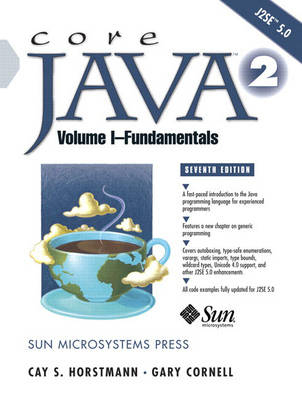
Core Java 2, Volume I--Fundamentals
Prentice Hall (Verlag)
978-0-13-148202-9 (ISBN)
- Titel erscheint in neuer Auflage
- Artikel merken
Completely revised and up-to-date coverage of
Generic programming, restrictions and limitations, type bounds, wilcard types, and generic reflection
Swing GUI development, including input validation and other enhancements
Exception handling and debugging, including chained exceptions, stack frames, assertions, and logging
Streams and files, the new I/O API, memory-mapped files, file locking, and character set encoders/decoders
Regular expressions using the powerful java.util.regex package
Inner classes, reflection, and dynamic proxies
Application packaging and the Preferences API
The seventh edition of Core Java™ 2, Volume I, covers the fundamentals of the Java 2 Platform, Standard Edition (J2SE™). A no-nonsense tutorial and reliable reference, this book features thoroughly tested real-world examples. The most important language and library features are demonstrated with deliberately simple sample programs, but they aren’t fake and they don’t cut corners. More importantly, all of the programs have been updated for J2SE 5.0 and should make good starting points for your own code. You won’t find any toy examples here. This is a book for programmers who want to write real code to solve real problems.
Volume I concentrates on the fundamental concepts of the Java language, along with the basics of user-interface programming and provides detailed coverage of
Object-oriented programming
Reflection and proxies
Interfaces and inner classes
The event listener model
Graphical user-interface design with the Swing UI toolkit
Exception handling
Stream input/output and object serialization
Generic programming
For the same real-world treatment of enterprise features and advanced user-interface programming, look for the forthcoming new edition of Core Java™ 2, Volume II—Advanced Features.
It includes new sections on metadata and other J2SE 5.0 enhancements along with complete coverage of: Multithreading • Distributed objects • Databases • Advanced GUI components • Native methods • XML Processing • Network programming • Collection classes • Advanced graphics • Internationalization • JavaBeans
Cay S. Horstmann is a professor of computer science at San Jose State University. Previously he was vice president and chief technology officer of Preview Systems Inc. and a consultant on C++, Java, and Internet programming for major corporations, universities, and organizations. Gary Cornell has written or cowritten more than twenty popular computer books. He has a Ph.D. from Brown University and has been a visiting scientist at IBM Watson Laboratories, as well as a professor at the University of Connecticut.
List of Code Examples.
Preface.
Acknowledgments.
1. An Introduction to Java.
Java as a Programming Platform.
The Java “White Paper” Buzzwords.
Java and the Internet.
A Short History of Java.
Common Misconceptions About Java.
2. The Java Programming Environment.
Installing the Java Development Kit.
Choosing a Development Environment.
Using the Command-Line Tools.
Using an Integrated Development Environment.
Compiling and Running Programs from a Text Editor.
Running a Graphical Application.
Building and Running Applets.
3. Fundamental Programming Structures in Java.
A Simple Java Program.
Comments.
Data Types.
Variables.
Operators.
Strings.
Input and Output.
Control Flow.
Big Numbers.
Arrays.
4. Objects and Classes.
Introduction to Object-Oriented Programming.
Using Predefined Classes.
Defining Your Own Classes.
Static Fields and Methods.
Method Parameters.
Object Construction.
Packages.
Documentation Comments.
Class Design Hints.
5. Inheritance.
Classes, Superclasses, and Subclasses.
Object: The Cosmic Superclass.
Generic Array Lists.
Object Wrappers and Autoboxing.
Reflection.
Enumeration Classes.
Design Hints for Inheritance.
6. Interfaces and Inner Classes.
Interfaces.
Object Cloning.
Interfaces and Callbacks.
Inner Classes.
Proxies.
7. Graphics Programming.
Introducing Swing.
Creating a Frame.
Positioning a Frame.
Displaying Information in a Panel.
Working with 2D Shapes.
Using Color.
Using Special Fonts for Text.
Doing More with Images.
8. Event Handling.
Basics of Event Handling
The AWT Event Hierarchy.
Semantic and Low-Level Events in the AWT.
Low-Level Event Types.
Actions.
Multicasting.
Implementing Event Sources.
9. User Interface Components with Swing.
The Model-View-Controller Design Pattern.
Introduction to Layout Management.
Text Input.
Choice Components.
Menus.
Sophisticated Layout Management.
Dialog Boxes.
10. Deploying Applets and Applications.
Applet Basics.
The Applet HTML Tags and Attributes.
Multimedia.
The Applet Context.
JAR Files.
Application Packaging.
Java Web Start.
Storage of Application Preferences.
11. Exceptions and Debugging.
Dealing with Errors.
Catching Exceptions.
Tips for Using Exceptions.
Logging.
Using Assertions.
Debugging Techniques.
Using a Debugger.
12. Streams and Files.
Streams.
The Complete Stream Zoo.
ZIP File Streams.
Use of Streams.
Object Streams.
File Management.
New I/O.
Regular Expressions.
13. Generic Programming.
Why Generic Programming?
Definition of a Simple Generic Class.
Generic Methods.
Bounds for Type Variables.
Generic Code and the Virtual Machine.
Restrictions and Limitations.
Inheritance Rules for Generic Types.
Wildcard Types.
Reflection and Generics.
Appendix A. Java Keywords.
Appendix B. Retrofitting JDK 5.0 Code.
Enhanced for Loop.
Generic Array Lists.
Autoboxing.
Variable Parameter Lists.
Covariant Return Types.
Static Import.
Console Input.
Formatted Output.
Content Pane Delegation.
Unicode Code Points.
Building Strings.
Index .
| Erscheint lt. Verlag | 26.8.2004 |
|---|---|
| Verlagsort | Upper Saddle River |
| Sprache | englisch |
| Maße | 179 x 236 mm |
| Gewicht | 1110 g |
| Themenwelt | Informatik ► Programmiersprachen / -werkzeuge ► Java |
| Mathematik / Informatik ► Informatik ► Web / Internet | |
| ISBN-10 | 0-13-148202-5 / 0131482025 |
| ISBN-13 | 978-0-13-148202-9 / 9780131482029 |
| Zustand | Neuware |
| Haben Sie eine Frage zum Produkt? |
aus dem Bereich


